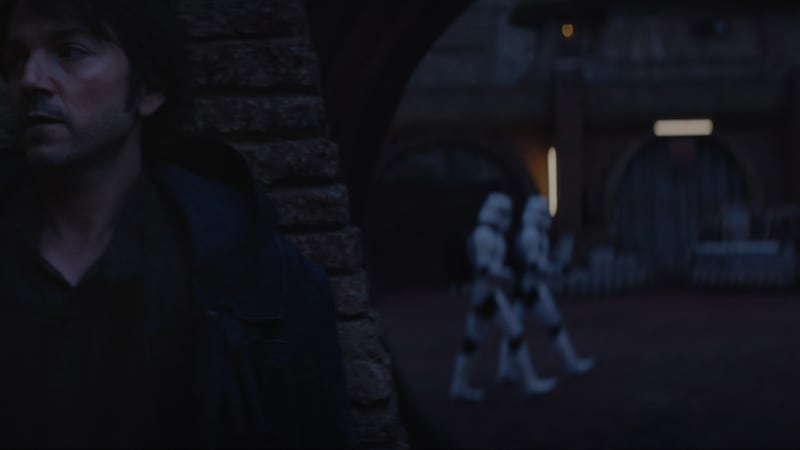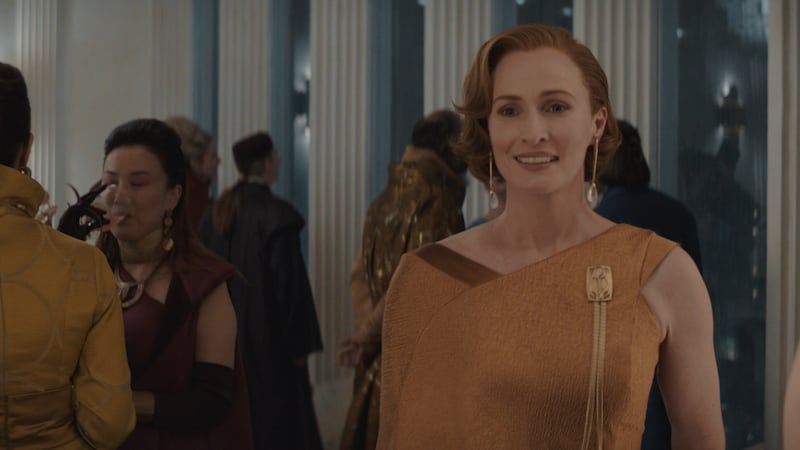Disney has largely mucked up Star Wars since purchasing it from George Lucas in 2012—save, that is, for Andor, the finest thing the franchise has produced since Darth Vader gave Emperor Palpatine the old heave-ho.
A prequel to the prequel film Rogue One, Tony Gilroy’s Disney+ hit is a portrait of the birth of a rebellious spirit, focused far less on force-related mythology than on the internal and external mechanisms of resistance, and in its second and final season, premiering April 22, it surpasses its impressive maiden run in every respect. Thrillingly intricate, suspenseful, tragic and hopeful, it fulfills the promise of the galaxy far, far away, telling a uniquely nuanced, mature, and gripping story that’s at once distinct from, and yet inherently wedded to, the Skywalker Saga upon which it’s founded.
Set a year after the conclusion of its first season, and four years before Rogue One, Andor picks up with its title character (Diego Luna) as he tries to steal a TIE fighter prototype from an Imperial test facility. As he tells his accomplice, the rebellion is vital because it means “you’re coming home to yourself.” Though his mission doesn’t go quite according to plan, the pilot gets the job done in a thrilling sequence that sets the pulse-pounding tone for the ensuing proceedings.
Every triumph, however, is seemingly followed by a new calamity. Reaching his rendezvous point, Andor discovers that his contact is MIA, and he immediately winds up in the middle of a feud between rival factions of a rebel group. This necessitates an escape plan, since he’s eager to make it to the farming planet of Mina-Rau, where he’s been stationed and where his love and partner-in-insurgency Bix (a phenomenal Adria Arjona) is waiting for him.

In the aftermath of her torture at the hands of an evil Imperial doctor, Bix is wracked by nightmares. She and her comrades (including chatty droid B2EMO) are soon scrambling to save their hiding hides when Imperial forces arrive on Mina-Rau looking to ferret out undocumented workers.
These are perilous times for the nascent rebellion, whether on distant planets or in the Coruscant chambers of political power, where senator Mon Mothma (Genevieve O’Reilly) is increasingly losing her diplomatic fight against the Empire and is covertly conspiring with Luthen Rael (Stellan Skarsgård) – the revolution’s mastermind – and his assistant Kleya (Elizabeth Dulau) to marshal a response to the Emperor’s authoritarian designs.
For Mon Mothma, that presently means keeping close tabs on her friend and co-conspirator Tay (Ben Miles), whose financial straits make him a potential liability, all as she oversees her daughter’s lavish ceremonial wedding to the son of Davo Sculdun (Richard Dillane), the untrustworthy businessman with whom she and Luthen have been compelled to partner.
Andor is a clockwork mechanism whose numerous gears interlock in complex ways, and Gilroy sets it in motion with ominous intrigue and exciting action. As Andor and Bix strive to avoid Imperial danger and reunite, the series partly shifts its attention to the planet of Ghorman, whose indigenous silk-spinning spiders provide textiles for the galaxy.
There’s an uprising known as the Ghorman Front brewing on this wealthy, historically peaceful, and strategically crucial outpost, and as explained by the Imperial Security Bureau’s Major Partagaz (Anton Lesser) to a hand-picked collection of commanders – including striving ISB supervisor Dedra Meero (Denise Gough) – it’s of the utmost importance to Palpatine, who covets its rare minerals.
Thus, the Empire sets a counterinsurgency scheme in motion that involves both promulgating anti-Ghorman propaganda and infiltrating the Front – the latter of which is left to Syril Karn (Kyle Soller), who relishes the chance to be a somebody and who is now in a full-fledged (and weirdly off-putting) romance with Dedra.
Andor is sprawling, but over the course of its 12 episodes it precisely delineates its many players and their knotty relationships to each other—as well as the personal hang-ups (like Syril’s issues with his domineering-with-a-smile mom, played by Kathryn Hunter) which inform their every decision.
Gilroy’s storytelling is elaborate and rich, dense with details and complications (some of them quite timely!) which speak to the multifaceted difficulties of rebellion—and, pressingly, to the immense sacrifices required by it, as evidenced by Luthen’s hard-hearted willingness to forfeit just about everything (including his soul, and life) for his cause. Even more than before, the series affords a sophisticated view of resistance as a logistical nightmare, a grave espionage game, and a struggle within, as each participant, on both sides, is repeatedly forced to wrestle with the meaning and consequences of their commitment.
While the cagey Luthen is referred to by Dedra (who’s desperate to discover his identity) as “Axis,” Andor revolves around Luna’s cynical freedom fighter, who despite being on board with Luthen’s campaign is still coming to terms with the lengths to which he must go to achieve his ends. Luna’s sternness is the shell that protects his tender heart, and the actor’s performance—determined, daring, subtly conflicted—girds the material.
Gilroy elicits terrific turns from everyone, particularly Arjona as the fractured Bix and O’Reilly as the squeezed-on-all-sides Mon Mothma, and his superb directors stage this intergalactic odyssey with cinematic grace and poise. Nicholas Britell’s intensely rousing score adds to the show’s grandeur, tension, and sense of solemn import.

Given that it leads directly into Rogue One, Andor invariably introduces into its mix a few familiar faces, from Ben Mendelsohn as the imperious Orson Krennic and Alan Tudyk as Andor’s formidable and sarcastic droid pal K-2SO to Benjamin Bratt—assuming the role originated by Jimmy Smits—as Alderaan senator Bail Organa.
Gilroy elegantly integrates his tale into the larger Star Wars framework without allowing those concerns to become priority number one; throughout, his focus remains on Andor’s, and by extension the rebellion’s, attempts to understand what it takes to topple an empire, and then to do it no matter the tremendous hazards and inevitable losses. Along the way, the showrunner crafts a host of indelible characters and delivers various urgent centerpieces, all while building toward revelations about the Empire’s true intentions—and, with them, the need to make terrible choices in order to safeguard the future.
Proving that, in the right hands, the franchise is a big umbrella under which different sorts of tones, approaches, and narratives can comfortably coexist, Andor is so good that it retroactively enhances the stature of Rogue One. It’s the sole modern Star Wars endeavor that lives up to its iconic original-trilogy predecessors.
The post ‘Andor’ Season 2 Proves This Is the Best Star Wars Saga Since the Original Trilogy appeared first on The Daily Beast.




